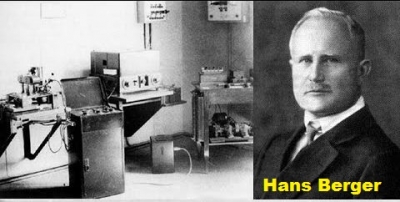
Electroencephalography is the process of recording and interpreting the electrical activity of the brain. The instrument used to do this is called an electroencephalograph and the resultant recording is called an electroencephalogram (EEG).
The first EEG reading was published in 1929, by a German scientist named Hans Berger. Hans Berger’s use of a string galvanometer was inspired by the electrocardiogram machine invented by Willem Einthoven.
In his initial experiments Berger exposed the surface of a dog’s brain and measured electrical currents in the outer part of its brain. Later, he placed electrodes under the scalp of humans who had part of their skulls removed during brain operations. He was able to record brain waves through the skull and collected EEGs from family, friends and other volunteers.
Berger identified two kinds of brain activity which he called ‘alpha waves’ and ‘beta waves’. EEGs show different patterns of brain waves during activities such as thinking, resting and sleeping.
Picture Credit : Google




